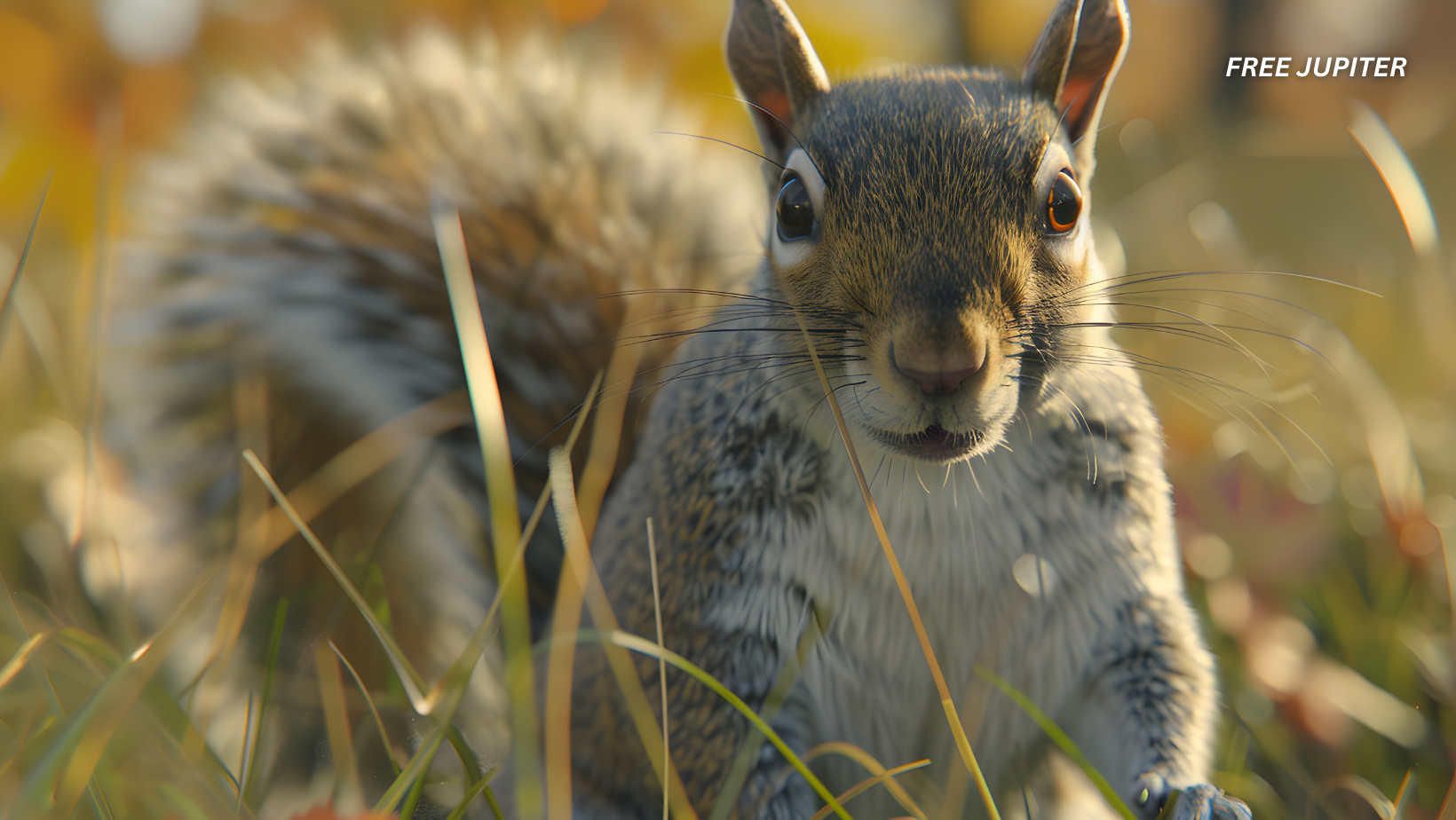It’s not every day that a suburban neighborhood has to put up warning flyers about a squirrel. Yet in the Lucas Valley area of San Rafael, California, residents have done exactly that. The reason? A particularly aggressive squirrel has been ambushing people, leaving behind claw marks, bites, and shaken nerves.
At least two individuals have ended up in the emergency room, while others have reported close calls or scratches. Flyers describe the creature bluntly as a “very mean squirrel” that “comes out of nowhere.” For many, the phrase might sound like the setup for a joke—but for the residents who have found themselves on the receiving end of a furry missile with sharp teeth, it’s anything but funny.
When Cute Turns Chaotic
Take the story of Joan Heblack, for example. She was simply out for a walk when she suddenly felt something latch onto her leg. Startled, she realized it was a squirrel—tail flailing, claws digging, teeth snapping. “It clamped onto my leg. I was screaming, trying to shake it off,” she recalled.
Another local, Isabel Campoy, had an even more dramatic encounter. She says the squirrel didn’t just attack from the ground. Instead, it launched itself upward, aiming for her face. She instinctively raised her arm to shield herself, but the animal clung on, leaving her arm bloodied. Like Heblack, she had to seek emergency medical treatment.
Though squirrels are small, anyone who has been scratched or bitten by one can confirm that their sharp teeth and nails can do real damage. Worse, attacks like these are startling because squirrels are usually considered harmless—more likely to dart away in a flash than to stage an ambush.
Read more: This Black Fungus Can Break Down Plastic Waste Into Edible Substances
A History of Mischievous Squirrels
While this squirrel in San Rafael might seem like an anomaly, it’s not the first time a squirrel has made headlines for troubling behavior.
- New York City’s Park Squirrels: In 2020, residents of Rego Park in Queens reported a rash of squirrel attacks. At least five people were bitten or scratched in just a few weeks. One woman described the experience as being “rushed by a furry bullet.” The culprit or culprits were never caught, but the incidents served as a reminder that urban wildlife can sometimes turn unpredictable.
- The Christmas Eve Squirrel Attack: Back in 2015, a squirrel in Meridian, Idaho, made news after terrorizing a family on Christmas Eve. The squirrel got into their house, caused chaos, and even bit one of the family members before being chased out.
- University Mascot Trouble: College campuses are notorious for bold squirrels. At Iowa State University, students jokingly refer to them as “campus security” because of how unafraid they are of humans. While most are harmless, a few have been known to snatch food straight out of students’ hands, leaving scratches in the process.
Clearly, the California “mean squirrel” is not the first to ruffle feathers—or fur—among humans. But what makes them behave this way?
Why Squirrels Sometimes Go Rogue
According to wildlife experts, squirrels don’t typically set out to be menaces. Their natural instinct is to avoid humans. Aggression often develops when they become too accustomed to people, especially when food is involved.
Lisa Bloch of Marin Humane explained that feeding wildlife is one of the leading causes of this behavior. Once an animal associates humans with easy meals, it may lose its natural fear. For squirrels, which are already bold little creatures, this can sometimes tip over into full-on harassment.
Another factor is territorial behavior. Like many animals, squirrels can be defensive if they feel their nest or food stash is threatened. While unlikely in suburban streets, it’s possible that the San Rafael squirrel views certain areas as “its turf.”
Finally, there’s simple curiosity and opportunism. Squirrels are remarkably intelligent rodents, capable of solving puzzles and remembering food hiding spots for months. Their sharp memory and adaptability allow them to thrive in cities, but those same traits can sometimes lead to surprising encounters with people.
Do Squirrels Carry Diseases?
One of the first concerns people have after a bite from a wild animal is the risk of rabies. Fortunately, squirrels in North America are not known carriers of the disease. This doesn’t mean their bites are harmless, though. Any bite or deep scratch can lead to infection if not treated properly, which is why Heblack, Campoy, and others ended up in the emergency room. Medical professionals often recommend tetanus shots or antibiotics after such encounters.
Beyond that, squirrels can carry parasites like fleas or ticks, but the risk to humans is relatively low compared to larger animals. Still, experts emphasize that wild animals should never be handled, fed, or treated like pets.
Read more: Tardigrade Proteins Might Help Protect Humans From Radiation, Researchers Say
When Humans and Wildlife Collide
The “mean squirrel” saga also shines a light on a broader issue: how humans coexist with wildlife in urban and suburban spaces. As cities expand into natural habitats, animals like squirrels, raccoons, coyotes, and even bears adapt to human presence. In many cases, these encounters are harmless—seeing a squirrel dart across the sidewalk or watching a raccoon rummage through trash cans. But when animals lose their natural caution, conflicts can arise.
The U.S. has seen its share of surprising animal encounters:
- In Colorado, black bears occasionally wander into residential neighborhoods, breaking into cars or even houses in search of food.
- In Florida, alligators sometimes show up in backyard pools.
- In Washington, coyotes have been reported chasing joggers.
While a squirrel attack might seem minor compared to those scenarios, it highlights the same underlying issue: feeding or unintentionally encouraging wildlife often leads to bolder behavior.
A Lesson in Coexistence
For San Rafael residents, the immediate question is what to do if the squirrel resurfaces. Bloch explained that if the attacks continue, Marin Humane will coordinate with state officials to trap and remove the animal safely. In the meantime, the best advice is simple: don’t feed the wildlife, and stay alert.
This isn’t just about preventing attacks. Feeding wild animals can disrupt ecosystems, alter their natural diets, and even harm their health. For example, bread and junk food are common “treats” people toss to animals, but they provide little nutrition and can cause long-term problems.
The Quirky Side of Squirrels
Of course, it’s worth remembering that squirrels are not just backyard villains. They’re also fascinating creatures in their own right. A few fun facts:
- Memory Masters: Squirrels bury thousands of nuts every year and can remember their hiding spots with astonishing accuracy, even months later.
- Acrobatic Athletes: Their flexible ankles can rotate 180 degrees, allowing them to climb down trees headfirst.
- Global Citizens: Squirrels exist almost everywhere in the world except Australia and Antarctica.
- Historic Intruders: In the early 1900s, squirrels were deliberately released into U.S. city parks to “enliven” urban life. Today, many city parks are overrun with them.
Read more: AI Is Learning to Decode Animal Speech — Could Humans Eventually Talk With Them?
The Story Continues
For now, the San Rafael squirrel seems to have calmed down, with no new reports of attacks since mid-September. But residents are still on guard, keeping an eye out for sudden rustling in the bushes or unexpected movement along fences.
The story has spread beyond Marin County, sparking both amusement and concern. Some shake their heads at the absurdity of a neighborhood on alert for a rogue squirrel, while others sympathize with the victims, knowing firsthand that even small animals can deliver big surprises.
In the end, the tale of the “very mean squirrel” serves as both a quirky headline and a cautionary reminder. Coexisting with wildlife means respecting boundaries, resisting the urge to feed wild animals, and remembering that even the fluffiest creatures have instincts—and teeth.
Featured image: Freepik.
Friendly Note: FreeJupiter.com shares general information for curious minds. Please fact-check all claims and double-check health info with a qualified professional. 🌱










